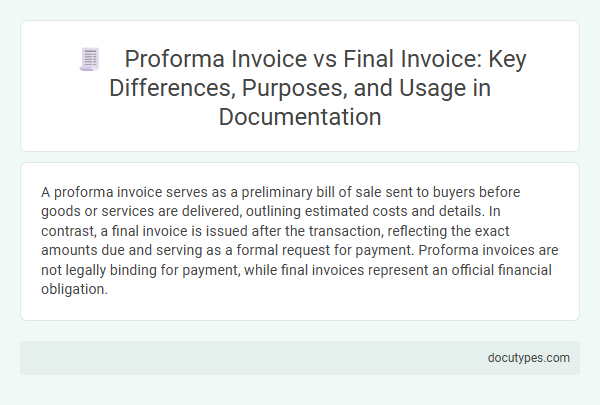A proforma invoice serves as a preliminary bill of sale sent to buyers before goods or services are delivered, outlining estimated costs and details. In contrast, a final invoice is issued after the transaction, reflecting the exact amounts due and serving as a formal request for payment. Proforma invoices are not legally binding for payment, while final invoices represent an official financial obligation.
Introduction to Invoices in Business Documentation
What distinguishes a proforma invoice from a final invoice in business documentation? Invoices serve as essential documents that outline the details of a transaction between a buyer and a seller. Your understanding of the differences ensures accurate financial management and clear communication.
What is a Proforma Invoice?
A Proforma Invoice is a preliminary bill of sale sent to buyers before the delivery of goods or services. It outlines the estimated costs, quantities, and details of the transaction, serving as a commitment to sell at specified prices.
This type of invoice is not a demand for payment but a document for customs or financial purposes. It helps buyers understand the expected charges and terms before the final invoice is issued.
What is a Final Invoice?
| Aspect | Final Invoice |
|---|---|
| Definition | A final invoice is an official document issued by a seller to a buyer after goods or services have been delivered and payment is due. It confirms the exact amount owed based on completed transactions. |
| Purpose | Serves as a legal request for payment and details the final cost, including taxes, discounts, and any additional fees. |
| Content | Includes product or service descriptions, quantities, unit prices, total amounts, payment terms, invoice number, and seller and buyer information. |
| Timing | Issued after delivery of goods or services and final agreement on terms has been reached. |
| Binding Nature | Legally binding document that supports accounting records and tax filing requirements. |
| Comparison to Proforma Invoice | Unlike a proforma invoice, which is a preliminary estimate or quote, the final invoice confirms the completed sale and exact payment due. |
Key Differences Between Proforma and Final Invoices
A proforma invoice serves as a preliminary bill of sale sent to buyers before the final sale is confirmed. A final invoice is the official request for payment after goods or services have been delivered.
- Purpose - A proforma invoice provides an estimate or quotation, while a final invoice demands actual payment.
- Legal Standing - The proforma invoice is not legally binding, but the final invoice acts as a legal document for the transaction.
- Content Detail - Proforma invoices contain estimated prices and terms, whereas final invoices list exact amounts and payment details.
You should always review both documents carefully to understand your payment obligations and transaction terms.
Purpose and Uses of Proforma Invoices
A proforma invoice serves as a preliminary document that outlines the details of a transaction before the final sale is confirmed. It helps in setting expectations and clarifying terms prior to issuing the final invoice.
- Purpose of Proforma Invoice - It provides an estimated cost for goods or services to assist in budgeting and approval processes.
- Uses in International Trade - Used to facilitate customs clearance and import/export documentation before shipment.
- Non-Binding Agreement - It does not demand payment but acts as a commitment to supply the described goods or services under specified conditions.
Purpose and Uses of Final Invoices
A proforma invoice serves as an initial estimate provided before a sale is finalized, outlining products, prices, and terms. It is not a demand for payment but a document for negotiation and approval.
The final invoice confirms the actual transaction details after goods or services are delivered. It serves as a formal request for payment and includes precise amounts due, payment terms, and deadlines. Your business relies on final invoices to accurately track revenue and maintain legal payment records.
Legal Status: Proforma vs Final Invoice
A proforma invoice serves as a preliminary document outlining the estimated costs and details of goods or services before a sale is finalized. It does not have legal standing as a demand for payment and cannot be used for accounting or tax purposes. In contrast, a final invoice is a legally binding document that confirms the sale, obligates payment, and is used for official financial records and tax compliance.
When to Issue Proforma vs Final Invoice
A proforma invoice is issued before the sale is finalized to provide the buyer with an estimated cost for goods or services. A final invoice is generated after the delivery or completion of the order, detailing the exact amount due. Proforma invoices help in obtaining approvals or arranging payments, while final invoices serve as official payment requests.
Sample Templates: Proforma and Final Invoices
A proforma invoice serves as a preliminary bill sent before goods or services are delivered, outlining estimated costs. A final invoice is the official document issued after the transaction, confirming the exact amount due.
Using sample templates for both proforma and final invoices helps ensure clarity and consistency in Your billing process.
- Proforma Invoice Template - Includes estimated prices, quantities, and terms to provide a clear quote before purchase confirmation.
- Final Invoice Template - Displays actual amounts, payment terms, and transaction details, reflecting the completed sale.
- Template Usage - Standardized templates reduce errors, streamline communication, and enhance professionalism in Your invoicing.
How Is a Proforma Invoice Different From a Final Invoice? Infographic

